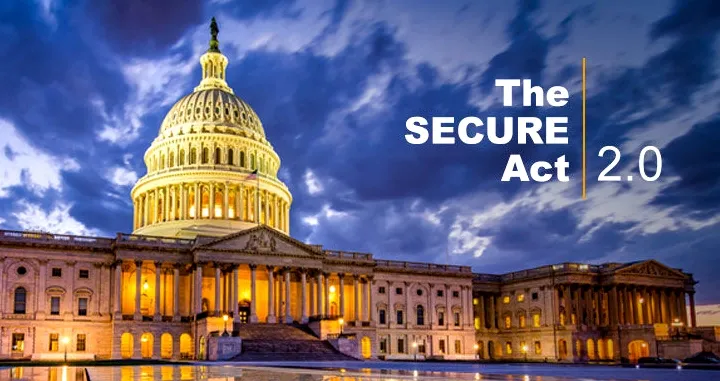Your New Tax Playbook for 2022
The rules surrounding RMDs have just recently changed under the SECURE Act, and are now being revamped once again, just as investors began to settle into finalizing their financial plans with the new rules. Thank you, Congress. Queue in, SECURE 2.0.
Last week, the House voted unanimously to pass “SECURE 2.0”, which includes various components that are shaking up families’ financial plans.
Among these, there is an increase to the age in which RMDs will begin, from the current 72 to 75 years old. If you’ve gone through our firm’s retirement planning process, then this should be no surprise to you. Being right outside of DC, we keep a close pulse on things going on downtown and have been our clients to be expecting this at some point.
There are also changes proposed to widen the Roth rules. Why? To bring in more revenue, of course. The revenue provisions include Roth versions of SEP and SIMPLE IRAs, as well as requiring catch-up provisions to be made to Roth accounts and allow employers to offer matching contributions to Roth accounts.
This is further evidence of how Congress loves Roth accounts—there is no deduction for making Roth contributions and brings in immediate revenue to fund other components of the bill.
If the currently bipartisan bill passes as law, then this would be the second time in three years that the RMD age has been raised. This is a few extra years that dollars can compound tax-deferred in retirement accounts but is complicated by the fact that inherited retirement assets are required to be fully distributed within 10 years if inherited by a non-spouse or otherwise exempted person.
As the bill moves to the Senate, many are confident that we may see this bill pass as is, while others believe changes are in order. Either way, there’s a great possibility that this bill will change the law for taxpayers going forward. Many agree that it will be attached to a must-pass bill, like the budget bill, but this is not a political piece. Hindsight will tell.
Here are the main takeaways for federal employees and their families as they continue to dial in their financial and retirement plans. This is further confirmation that “planning is a process, not an event”—a phrase that many of you have seen us repeat like a broken record.
While there were several proposed changes in the bill, many are very specific so we’ll focus on the ones most likely to impact the federal community.
Waiting Longer to Draw from Retirement
The original SECURE Act raised the Required Minimum Distribution (RMD) age from 70.5 to 72 years old. SECURE 2.0 would again raise the minimum age to 75 over the next decade. The age for RMDs would initially increase to 73 starting on January 1, 2023, then to age 74 on January 1, 2030. It would rise to 75 on January 1, 2033.
In portfolio management, the Time Value of Money (TVM) measures the value of money now relative to its value in the future. We know that the value of money goes down over time due to inflation, which clocked in at a whopping almost 8% earlier this year.
Increasing the RMD age allows your money to stay invested and grow that much longer to combat “the silent portfolio killer”, known as inflation.
But this will be nominal given how the change has been stretched over a decade. Frankly, many people will die before experiencing the full conversion. Changing the calculation over and over has become annoying to investors and their advisors. It seems irrelevant, in my own opinion, especially since after death, non-spouse beneficiaries must empty the account within 10 years anyway.
The other side of the coin is that increasing RMD age without proportionally increasing life-expectancy means that RMDs rates will become accelerated, and higher amounts will need to be taken in years. Where will tax rates be? Difficult to know, easier to guess. Will that cause more of this money to be taxed at a higher rate? It will for the overwhelming majority of investors, thus the point.
RMD Penalty Reduction
Currently, if you fail to take your RMD, your penalty is 50% of what should have been taken. That’s steep punishment. To be fair, many taxpayers can get away with missing a few RMDs without being penalized, if there was a reasonable cause. You would file Form 5329 and a letter. The new rule changes this to 25% and can be further reduced to 10% if the mistake is corrected timely.
Auto-Enrollment and Incentives in Retirement Plans
This one is less for federal employees, as feds are automatically enrolled into the TSP already. But if you have a spouse or children who work in the private sector, this is something introduced in the bill that has been way overdue. Some plans may also receive provisions allowing them to provide additional incentives in helping their employees save more for their retirements. This one is still as clear as mud.
New Catch-Up Limits
The maximum amount for catch-up contributions will also change for some TSP participants. The legislation increases the catch-up contribution limit to $10,000 for TSP participants between the ages of 62 and 64.
It is currently set to $6,500 for those 50 and up. The new bill keeps that limit for those between 50 and 61 and anyone over 65.
Circular, if you ask me. I might have said to increase the limits for everyone, but that conflicts in favor of helping people instead of helping Congress meet goals, but I digress.
Employer Matching on Student Loans
Many people carry student loans will into their careers, especially if they’re not close to retirement yet. In most cases, it makes better sense to pay off the loans than hasten retirement account contributions, especially if they have high interest rates. The new rule would allow employees to make matching contributions to a worker’s retirement account based on the worker’s own student loan payment.
Qualified Charitable Distribution (QCD) Enhancement
Certain investors can transfer up to $100,000 tax-free from their IRAs to a charity. These distributions can qualify as a part of your RMD, but you will not pay the taxes if it’s qualified charity. The new rule would index the $100,000 cap for inflation and allow a one-time QCD transfer of up to $50,000 through a charitable gift annuity or charitable remainder trust (CRT). This can be a nice planning tool for a dual-earning family or otherwise high income.
Relief for Domestic Abuse Victims
Withdrawals from retirement accounts prior to 59.5 years old had very few exemptions from the 10% penalty. On top, you’d pay ordinary income tax as well. This new rule would add another exception waiting the 10% penalty on the lesser of $10,000 or 50% of the account balance for people who self-certify they have been a victim of domestic abuse. The income tax would be allowed to be paid over three years, and any amounts recontributed within three years wouldn’t be taxable.
Take this as a moment to review your plan with your advisors and ask them how these changes will be impacting your plan. There may be areas for you to strengthen your financial position when laws like these see changes. The only way to know is to run the numbers, so waste no more time—after all it’s not just your money, it’s your future.




